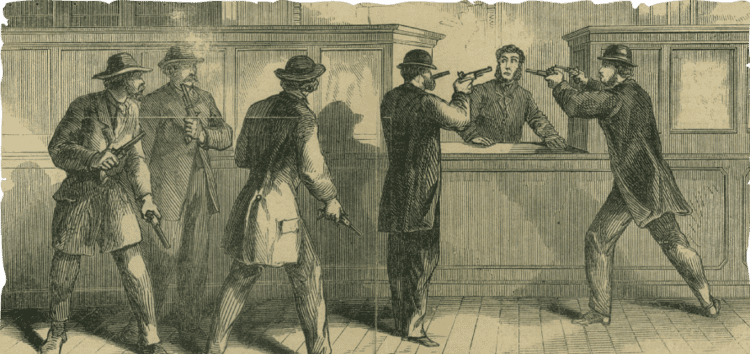local police and militia 21 cavalry Date 19 October 1864 | 1 killed2 wounded 1 wounded | |
 | ||
Similar American Civil War, Fenian raids, Battle of Cedar Creek, Battle of Portland Harbor, Chesapeake Affair | ||
St albans raid siv370
The St. Albans Raid was the northernmost land action of the American Civil War. It was a controversial raid from Canada by Confederate soldiers meant to rob banks to raise money and to trick the Union Army into diverting troops to defend their northern border against further raids. It took place in St. Albans, Vermont, on October 19, 1864.
Contents

St albans raid civil war drive by
Background

In this wartime incident, Kentuckian Bennett H. Young led the Confederate States Army forces. Young had been captured after the Battle of Salineville in Ohio ended Morgan's Raid the year before. He managed to escape to Canada, then part of the British Empire. After meeting with Confederate agents there, he returned to the Confederacy, where he proposed raids on the Union from the Canada–US border to build the Confederate treasury and force the Union Army to divert troops from the South. Young was commissioned as a lieutenant and returned to Canada, where he recruited other escaped Confederates for a raid on St. Albans, Vermont, a quiet city just 15 miles (24 km) from the Canada–US border.
Raid
Young and two others checked into a local hotel on October 10, saying they had come from St. John's, Canada East, for a "sporting vacation". Two or three more men arrived daily, until by October 19, 21 Confederate cavalrymen had assembled. Shortly before 3 p.m. the men staged simultaneous robberies of the city's three banks. They identified themselves as Confederate soldiers and took a total of $208,000 (US$ 3,190,000 in 2017). During the robberies, eight or nine Confederates held the villagers at gun point on the village green, taking their horses to prevent pursuit. Several armed villagers tried to resist, and one was killed and another wounded. Young ordered his men to burn the city, but the 4-US-fluid-ounce (120 ml) bottles of Greek fire they used failed to ignite, and only one shed was destroyed by fire.
The raiders escaped to Canada, despite a delayed pursuit. In response to U.S. demands, the Canadian authorities arrested the raiders, recovering $88,000. However, a Canadian court ruled that because they were soldiers under military orders, officially neutral Canada could not extradite them. Canada freed the raiders, but returned to St. Albans the money they had found.
As an unintended consequence, the raid served to turn many Canadians against the Confederacy, since they felt that Canada was being drawn into the conflict without its consent. The Confederate agents in Canada realized this and no further raids were made.
Only one of the three banks still stands, the Franklin County Bank, which became the Franklin Lamoille Bank and is now a TD Bank branch. Other sites surviving are Taylor Park and the American House, where some of the raiders stayed.
Battle or raid?
The Confederate raid by Confederate Brig. Gen. John Hunt Morgan into Ohio and Indiana in July 1863, and culminating in the Battle of Salineville is considered by many historians to be the northern most land battle of the Civil War. The dispute arises over meaning of the word battle. The St. Albans raiders were not an official command of the Confederate army but connected to the Confederate Secret Service to conduct the St. Albans Raid. General Morgan’s place of surrender at West Point, Ohio is considered to be the northernmost point reached by an officially organized Confederate military body during the Civil War. The northernmost battle of the war came at sea at the Battle of Cherbourg (1864) at 49 degrees north latitude.
Film
The 1954 film The Raid was loosely based on this incident.
